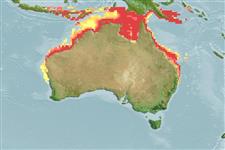>
Scombriformes (Mackerels) >
Scombridae (Mackerels, tunas, bonitos) > Scombrinae
Etymology: Scomberomorus: Latin, scomber = mackerel + Greek, moros = silly, stupid (Ref. 45335).
More on author: Macleay.
Environment: milieu / climate zone / depth range / distribution range
Οικολογία
Θαλασσινό(ά); Υφάλμυρο; ωκεανόδρομο(ς) (Ref. 51243); εύρος βάθους ? - 100 m (Ref. 6390). Tropical; 7°S - 30°S, 112°E - 157°E (Ref. 168)
Western Pacific: southern Papua New Guinea and northern Australia, from Shark Bay, Western Australia to northern New South Wales. Reports of this species from Thailand and Malaysia are based on misidentifications.
Length at first maturity / Μέγεθος / Βάρος / Age
Maturity: Lm ?, range 75 - ? cm
Max length : 120 cm FL αρσενικό/απροσδιόριστο; (Ref. 168); μεγ. δημοσιευμένο βάρος: 10.0 kg (Ref. 168)
Ραχιαίες άκανθες (συνολικά): 13 - 15; Μαλακές ραχιαίες ακτίνες (συνολικά): 19-22; Εδρικές άκανθες 0; Μαλακές εδρικές ακτίνες: 19 - 22; Σπόνδυλοι: 44 - 46. Interpelvic process small and bifid. Lateral line gradually curving down toward caudal peduncle. Intestine with 2 folds and 3 limbs. Swim bladder absent. Body covered with small scales. Juveniles (less than 10 cm) marked with 12-20 vertical bands which becomes less distinct or break into spots in larger fish.
Found more commonly around coastal headlands and rocky reefs but are also caught offshore (Ref. 6390). Juveniles (4.5 to 10 cm length) are commonly encountered during November along the beaches of Townsville, Queensland and grow to twice this size by January. They are pelagic predators, feeding exclusively on baitfish (sardines and herrings (Ref. 30572). Caught also with set lines aside from trolling with small lures or cut bait. Marketed fresh and frozen; eaten fried, broiled and baked (Ref. 9988).
Collette, B.B. and C.E. Nauen, 1983. FAO Species Catalogue. Vol. 2. Scombrids of the world. An annotated and illustrated catalogue of tunas, mackerels, bonitos and related species known to date. Rome: FAO. FAO Fish. Synop. 125(2):137 p. (Ref. 168)
IUCN Red List Status (Ref. 130435)
Threat to humans
Reports of ciguatera poisoning (Ref. 6390)
Human uses
αλιεία: Εμπορικό(ά); αλιεία αναψυχής: ναί; δόλωμα: occasionally
Περισσότερες πληροφορίες
ΑναφορέςΥδατοκαλλιέργειεςΠροφίλ υδατοκαλλιέργειαςΣτελέχοιΓενετικήElectrophoresesΚληρονομικότηταΑσθένειεςΜεταποίησηNutrientsMass conversion
ΣυνεργάτεςΦωτογραφίεςStamps, Coins Misc.ΉχοιΣιγκουατέραΤαχύτηταΚολυμβητικός ΤύποςΕπιφάνεια βραγχίωνOtolithsΕγκέφαλοιΌραση
Εργαλεία
Special reports
Download XML
Διαδικτυακές πηγές
Estimates based on models
Preferred temperature (Ref.
123201): 25.9 - 28.7, mean 27.7 °C (based on 506 cells).
Phylogenetic diversity index (Ref.
82804): PD
50 = 0.5000 [Uniqueness, from 0.5 = low to 2.0 = high].
Bayesian length-weight: a=0.00832 (0.00383 - 0.01808), b=3.03 (2.86 - 3.20), in cm total length, based on LWR estimates for this Genus-body shape (Ref.
93245).
Τροφικό Επίπεδο (Ref.
69278): 4.5 ±0.80 se; based on food items.
Ελαστικότητα (Ref.
120179): Μεσαίο(α), ελάχιστος χρόνος για διπλασιασμό πληθυσμού 1,4 - 4,4 έτη (K=0.6; tm=1-2; tmax=12).
Fishing Vulnerability (Ref.
59153): Moderate to high vulnerability (49 of 100).
Nutrients (Ref.
124155): Calcium = 31.7 [14.5, 120.3] mg/100g; Iron = 0.836 [0.391, 2.033] mg/100g; Protein = 21 [20, 22] %; Omega3 = 0.287 [0.173, 0.471] g/100g; Selenium = 64.2 [23.0, 279.1] μg/100g; VitaminA = 15.9 [3.3, 73.6] μg/100g; Zinc = 0.701 [0.470, 1.102] mg/100g (wet weight);
